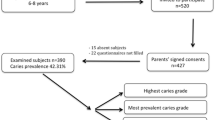Abstract
Aim
This study focused on the risk factors in mother–child relationship that predispose babies to the development of dental caries.
Methods
A prospective cohort study with 80 mother–child pairs was conducted. The mothers responded at 12, 18 and 30 months after their children’s birth, to questions about variables related to diet, sucking habits, and oral care. Children were clinically examined to verify caries lesions (white spot lesions or cavitation). Data were analysed using Chi squared or Fisher’s exact tests. The significance level was set at 5 %.
Results
Of the total, 3.75 % showed cavitated lesions after 18 months; 6.25 and 45 % had spot white lesions, respectively, at 18 and 30 months. The cariogenic diet was high at 12 (63.75 %) and 30 (88.75 %) months. Good oral hygiene was present in a minority of children at 12 months (46.25 %), but increased at 30 months (65 %), helping to prevent cavities and white spot lesions over this period (p = 0.0005). The variables of the blocks sucking habits and diet were not associated with caries.
Conclusion
The lack of oral care in children was a risk factor for dental caries development.

Similar content being viewed by others
References
Abiola AA, Eyitope OO, Sonny OJ, Oyinkan OS. Dental caries occurrence and associated oral hygiene practices among rural and urban Nigerian pre-school children. J Dent Oral Hyg. 2009;1:64–70.
American Academy of Pediatric Dentistry. 2013–14 Definitions, oral health policies, and clinical guidelines. http://www.aapd.org/Policies/. Accessed 10 Oct 2013.
Ayres M, Ayres MJR, Ayres DL, Santos AS. BioEstat 5.0. statistical applications in the biological and medical sciences areas. Belém, Mamirauá Civil Society. 2007.
Brazil. Ministry of Health. SB Brazil 2003 project: dental health conditions of the Brazilian population 2002–2003: main results. Brasília; 2004.
Cruz AAG, Gadelha CGF, Cavalcanti AL, Medeiros PFV. The perception of mothers about babies oral hygiene: a study in the hospital Alcides Carneiro, Campina Grande—PB. Pesqui Bras Odontopediatria Clin Integr. 2004;4:185–9.
Davidoff DCO, Abdo RCC, Silva SMB. Early childhood caries prevalence. Pesqui Bras Odontopediatria Clin Integr. 2005;5:215–21.
Dean AG, Arner TG, Sunki GG, Friedman R, Lantinga M, Sangam S, et al. Epi Info™, a database and statistics program for public health professionals. Atlanta: Centers for Disease Control and Prevention; 2008.
De Grawe A, Aps JK, Martens LC. Early childhood caries (ECC): what’s in a name? Eur J Paediatr Dent. 2004;5:62–70.
Fadel CB, Saliba NA, Moimaz SAS. Mother-child relation: an interdisciplinary approach and their unfoldings for dentistry. Arq Odontol. 2008;44:42–8.
Fejerskov O. Changing paradigms in concepts on dental caries: consequences for oral health care. Caries Res. 2004;38:182–91.
Furze H, Basso M. The first dental visit: an Argentine point of view. Int J Paediatr Dent. 2003;13:266–8.
Jin BH, Ma DS, Moon HS, Paik DI, Hahn SH, Horowitz AM. Early childhood caries: prevalence and risk factors in Seoul, Korea. J Public Health Dent. 2003;63:183–8.
King NM, Wu IIM, Tsai JSJ. Caries prevalence and distribution, and oral health habits of zero- to four-year-old children in Macau, China. J Dent Child. 2003;70:243–9.
Kiwanuka SN, Astrom AN, Trovik TA. Dental caries experience and its relationship to social and behavioral factors among 3-5-year-old children in Uganda. Int J Paediatr Dent. 2004;14:336–46.
Leong PM, Gussy MG, Barrow SY, Silva-Sanigorski A, Waters E. A systematic review of risk factors during first year of life for early childhood caries. Int J Paediatr Dent. 2013;23:235–50.
Mahesh R, Muthu MS, Rodrigues SJL. Risk factors for early childhood caries: a case–control study. Eur Arch Paediatr Dent. 2013;14:331–7.
Misra S, Tahmassebi J, Brosman M. Early childhood caries—a review. Dent Update. 2007;34:556–8.
Meira Filho MMO, Araújo DTC, Menezes VA, Granville Garcia AF. The child’s dental treatment: maternal perception. RGO. 2009;57:311–5.
Moimaz SAS, Martins RJ, Forte FDS, Saliba NA. Oral hygiene practices, parents’ education level and dental caries pattern in 0 to 5 years-old children. Braz J Oral Sci. 2005;4:778–82.
Moimaz SAS, Saliba O, Lolli LF, Garbin CAS, Garbin AJI, Saliba NA. A longitudinal study of the association between breast-feeding and harmful oral habits. Pediatr Dent. 2012;34:117–21.
Peressini S. Pacifier use and early childhood caries: an evidence—based study of the literature. J Can Dent Assoc. 2003;69:16–9.
Rosenblatt A, Zarzar P. The prevalence of early childhood caries in 12- to 36-month-old children in Recife, Brazil. ASDC J Dent Child. 2002;69:319–24.
Saliba NA, Moimaz SAS, Tiano AVP. Fluoride level in public water supplies of cities from the northwest region of São Paulo State, Brazil. J Appl Oral Sci. 2006;14:346–50.
Tiano AVP, Moimaz SAS, Saliba O, Saliba NA. Dental caries prevalence in children up to 36 months of age attending daycare centers in municipalities with different water fluoride content. J Appl Oral Sci. 2009;17:39–44.
Vadiakas G. Case definition, aetiology and risk assessment of early childhood caries (ECC): a revisited review. Eur Arch Paediatr Dent. 2008;9:114–25.
Acknowledgments
We would like to thank the Brazilian Federal Agency for Support and Evaluation of Graduate Education (CAPES) and the Agency of the São Paulo Research Foundation (FAPESP) for providing funding for this work.
Author information
Authors and Affiliations
Corresponding author
Rights and permissions
About this article
Cite this article
Moimaz, S.A.S., Garbin, A.J.Í., Lima, A.M.C. et al. Risk factors in the mother-child relationship that predispose to the development of early childhood caries. Eur Arch Paediatr Dent 15, 245–250 (2014). https://doi.org/10.1007/s40368-014-0108-1
Received:
Accepted:
Published:
Issue Date:
DOI: https://doi.org/10.1007/s40368-014-0108-1




